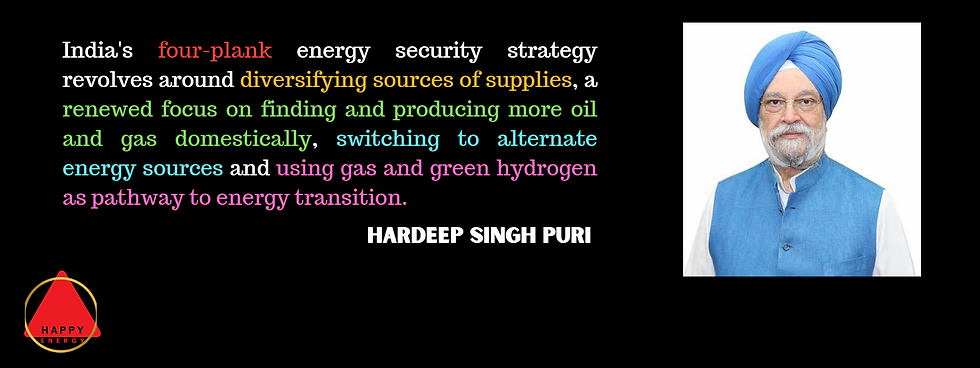India plays a key role in the global response to the climate change. However, it has an obligation to meet the developmental needs of 20% of the world population. Energy security is pertinent to provide a reliable energy to the billions.
India's energy security is based on the following four pillars, popularly titled as 4 Plank strategy to energy sector:
Diversifying supplies
Increasing Exploration & Production
Alternate Energy Sources
Energy transition through a gas-based economy, Green Hydrogen, and EVs.

1. Diversify Sources of Supplies:
India is dependent on the imports to meet more than 83% of its crude oil requirements and to the extent of about 47% in case of natural gas. India increases the number of crude oil suppliers from 27 countries in 2006-07 to 39 in 2021-22.
India is also focusing on diversifying its energy mix. Energy mix is defined as the diversification of the energy sources like coal, oil, natural gas, nuclear, hydropower, renewables, and not particularly dependent on any particular fuel.
One note-worthy principle with the energy-mix is (N-1) Principle. If a country maintains N sources of energy, it must be able to meet its energy requirements, even if one of its sources of supply is disrupted.
A few initiatives in this field are importing Russial oils, holding a strategic oil reserve in phased manner, having strategic energy security pact with countries like US, Israel, or other African Nations, and focusing on creating infrastructure in the resource rich countries like Afghanistan like TAPI pipelines, Ashgabat Agreement, etc.
2. Increasing Exploration & Productions
If India needs to continue with the growth trajectories, it needs to invest in exploration and production which would expand its energy sources with untapped sources. India has understood this now and has invested in strategy like New Exploration Licensing Policy (NELP) and Coal Bed Methane Policy in 1990s and opened doors for the private sectors and foreign entities to participate in this journey of exploration.
A few initiatives in this field are Hydrocarbon Exploration and Licensing Policy (HELP) coupled with operationalization of Open Acreage Licensing Policy (OALP), Policy framework to permit exploration and exploitation of unconventional hydrocarbons in existing acreage of Production Sharing Contracts, having National Data Repository (NDR), etc.
3. Alternate Energy Sources:
Clean energy sources have been the buzzwords in the climate science domains for quite a while. Alternate Energy Sources can be a game-changer in the journey to the climate change.
Alternative energy sources are the energy that does not come from fossil fuels, and thus does not generate greenhouses gases. They represent the alternative of coal, oil, and natural gas which are presently the commonly used energy sources across the world.
Coal used in the generation of electricity is being increasingly replaced by other resources like nuclear, solar, wind, and hydropower. Oil is primarily used in the transport and industries. The Indian industries are moving fast in the direction to gas-based economy with less dependence on the oil. Transport is adopting electrical vehicles, biofuels blending, and hydrogen fuel-cell based vehicles at a fast pace.
4. Energy Transition
Indian government is working in a mission-mode to promote the energy transition through a faster adoption of electrical vehicles vide various schemes like FAME and Green Hydrogen Mission.
India is also actively transitioning to the gas-based economy, and increased focus on improving fuel efficiency, and energy efficiency.
Key highlights of the above blog are presented in the given infographics.



Brief and clear.
🙇♀🙏✔️👏👏